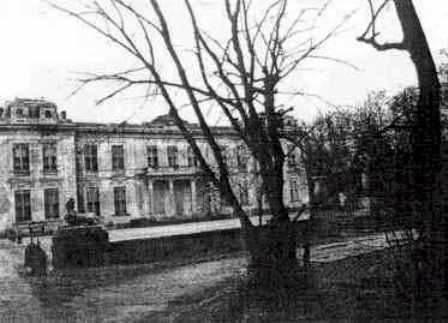In 1774, Sara Raba, a merchant’s widow, driven from Portugal by the Inquisition, bought 80,000 “livres” from the daughters of Pierre Baillet the noble fief of Coudournes, also called the “Guionnet House”. In this house, according to tradition, Henri IV had slept the night before the battle of Coutras in 1587. The eight Raba brothers were all merchants except the third, who was a doctor.

Château Raba
The Raba family demolished the Guionnet house to build the 18th century villa. It is a one-story rectangular building. At each end are two projecting pavilions covered by a “brisis” roofing. In the center, a porch with four ionic columns supports a coping. Above this, a balustrade forms a balcony. However, what is more original is a small low building at the end of the outbuildings, formerly a concert hall. The entrance, framed by Tuscan columns, supports a coping decorated with urns, in the center of which is a bas-relief representing a bust surrounded by beams of light.

Château Raba
Below this, a triangular pediment decorated with cherubs in the tympanum rests on large piles of bossage (stones that have been cut roughly and often laid into position for later finishing) This room was decorated with tapestries and many paintings. The villa itself was luxuriously furnished and decorated with art objects. But the interest of this villa resides especially in its park which gave Raba the nickname “Chantilly Bordelais.”

Château Raba
The lawns were decorated with statues and fountains; sphinxes guarded the chateau; paths lined with beautiful trees led to aviaries; there were hedges, a labyrinth and a pavilion of the Muses. There were also little constructions inhabited by automatons (robots) , a mill, a sheep pen, a little alms-house , a sort of truth machine, etc.

Details – Château Raba
Artificial animals, both domestic and wild, populated the area and sometimes frightened visitors. This was an amusement park ahead of its time and a kind of patronage, because the Raba family let strollers enjoy their property, even encouraging them to visit their salons and the music room. Celebrities came to visit the famous Chantilly. The Parliament of Bordeaux came as a group, as well as Beaumarchais and in 1808, Napoleon and Josephine.

Details – Château Raba
At the time of the Revolution, the Rabas were worried like all of those whose fortune attracted attention. But like the Peixottos, they got away with a fine and protestations of good citizenship. The Revolution needed merchants and bankers for supplies and most of them recovered their property.
Today the music salon and the orangery (greenhouse) inhabited by the family’s descendants, and the guesthouse, built later and rented to a Child Protection agency, are still in good condition. But the chateau itself, which has lost part of its roofing, is slowly falling into disrepair.
Translated, with the permission of the author, Ms. Francine Musquère, from the original French versions by Laura K. Yost. Originally published on “Talance à travers le siécles” in 1986